For the 2025 school year, there are 2 public middle schools serving 262 students in Warrenton-Hammond SD 30 School District. This district's average middle testing ranking is 5/10, which is in the bottom 50% of public middle schools in Oregon.
Public Middle Schools in Warrenton-Hammond SD 30 School District have an average math proficiency score of 22% (versus the Oregon public middle school average of 29%), and reading proficiency score of 42% (versus the 45% statewide average).
Minority enrollment is 32% of the student body (majority Hispanic), which is less than the Oregon public middle school average of 38% (majority Hispanic).
Overview
This School District
This State (OR)
# Schools
4 Schools
475 Schools
# Students
974 Students
172,638 Students
# Teachers
58 Teachers
9,438 Teachers
Student : Teacher Ratio
16:1
16:1
District Rank
Warrenton-Hammond SD 30 School District, which is ranked within the bottom 50% of all 186 school districts in Oregon (based off of combined math and reading proficiency testing data) for the 2021-2022 school year.
The school district's graduation rate of 75-79% has stayed relatively flat over five school years.
Overall District Rank
#147 out of 189 school districts
(Bottom 50%)
(Bottom 50%)

Math Test Scores (% Proficient)
20%
31%
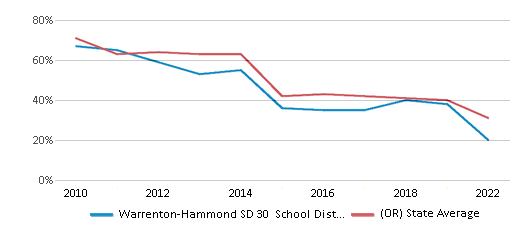
Reading/Language Arts Test Scores (% Proficient)
34%
44%
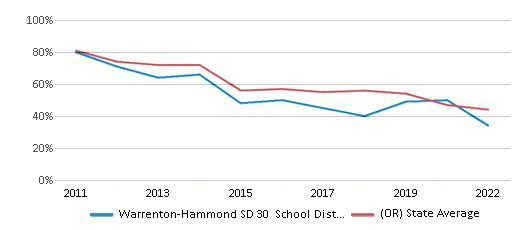
Science Test Scores (% Proficient)
20-24%
30%
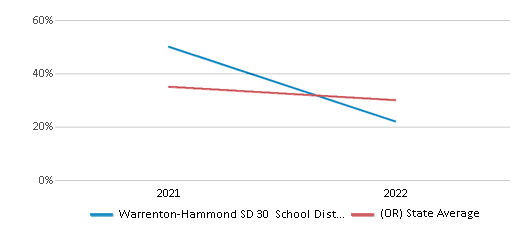
Graduation Rate
75-79%
81%
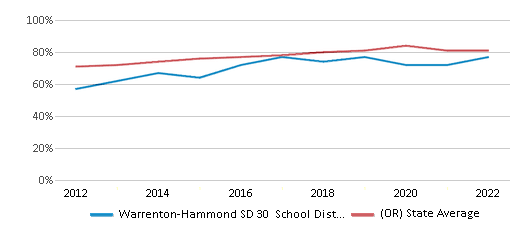
Students by Ethnicity:
Diversity Score
0.47
0.57
# American Indian Students
7 Students
2,254 Students
% American Indian Students
1%
1%
# Asian Students
6 Students
5,936 Students
% Asian Students
1%
4%
# Hispanic Students
177 Students
39,278 Students
% Hispanic Students
18%
23%
# Black Students
7 Students
3,780 Students
% Black Students
1%
2%
# White Students
683 Students
106,509 Students
% White Students
70%
62%
# Hawaiian Students
12 Students
1,300 Students
% Hawaiian Students
1%
1%
# Two or more races Students
78 Students
12,598 Students
% of Two or more races Students
8%
7%
Students by Grade:
# Students in PK Grade:
-
-
# Students in K Grade:
65
4,237
# Students in 1st Grade:
74
4,821
# Students in 2nd Grade:
81
5,092
# Students in 3rd Grade:
73
5,098
# Students in 4th Grade:
64
5,601
# Students in 5th Grade:
68
6,096
# Students in 6th Grade:
78
36,431
# Students in 7th Grade:
92
41,680
# Students in 8th Grade:
72
42,445
# Students in 9th Grade:
74
4,601
# Students in 10th Grade:
79
5,099
# Students in 11th Grade:
83
5,416
# Students in 12th Grade:
71
6,021
# Ungraded Students:
-
-
District Revenue and Spending
The revenue/student of $20,857 is higher than the state median of $18,279. The school district revenue/student has stayed relatively flat over four school years.
The school district's spending/student of $42,732 is higher than the state median of $19,325. The school district spending/student has stayed relatively flat over four school years.
Total Revenue
$20 MM
$9,902 MM
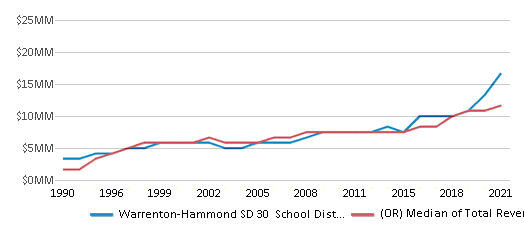
Spending
$42 MM
$10,468 MM
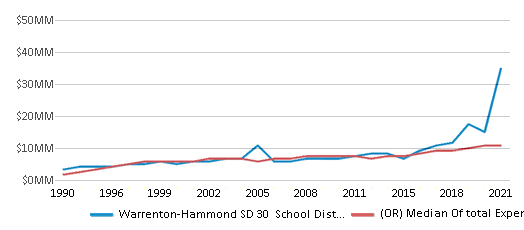
Revenue / Student
$20,857
$18,279
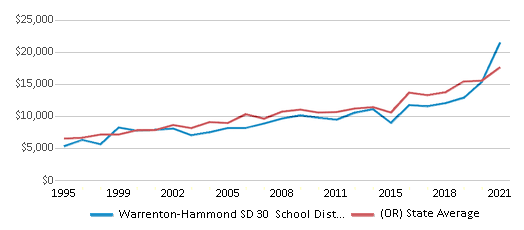
Spending / Student
$42,732
$19,325
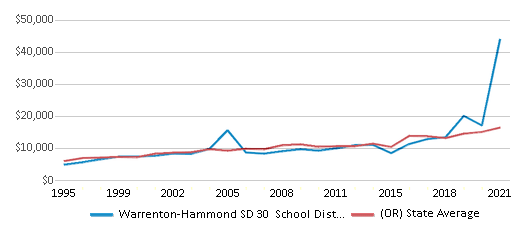
Best Warrenton-Hammond SD 30 School District Public Middle Schools (2025)
School
(Math and Reading Proficiency)
(Math and Reading Proficiency)
Location
Grades
Students
Rank: #11.
Warrenton Middle School
(Math: 20-24% | Reading: 40-44%)
Rank:
Rank:
5/
Bottom 50%10
1050 Se Warrior Way
Warrenton, OR 97146
(503) 861-2281
Warrenton, OR 97146
(503) 861-2281
Grades: 6-8
| 242 students
Rank: n/an/a
Warrior Academy
Alternative School
820 Sw Cedar Ave
Warrenton, OR 97146
(503) 861-2281
Warrenton, OR 97146
(503) 861-2281
Grades: 6-12
| 20 students
Recent Articles

What Is A Charter School?
Explore the world of charter schools in this comprehensive guide. Learn about their history, how they operate, and the pros and cons of this educational innovation. Discover key facts about charter schools, including admission policies, demographics, and funding, as well as what to look for when considering a charter school for your child.

10 Reasons Why High School Sports Benefit Students
Discover the 10 compelling reasons why high school sports are beneficial for students. This comprehensive article explores how athletics enhance academic performance, foster personal growth, and develop crucial life skills. From improved fitness and time management to leadership development and community representation, learn why participating in high school sports can be a game-changer for students' overall success and well-being.

February 05, 2025
Understanding the U.S. Department of Education: Structure, Impact, and EvolutionWe explore how the Department of Education shapes American education, from its cabinet-level leadership to its impact on millions of students, written for general audiences seeking clarity on this vital institution.





